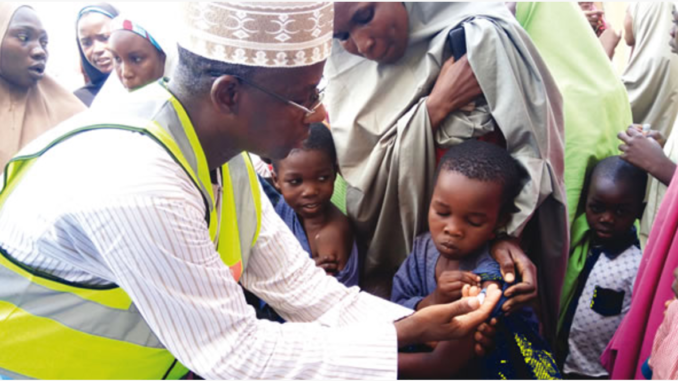
State governments have been told to take charge of primary health care in their domains as the era of federal might is over. The Minister of Health, Isaac Adewole, declared this recently, stressing the obvious that it will guarantee quality health service delivery across the country. Nigeria has a broken health care system, which ensures the encumbrance of tertiary health centres with cases that should have been taken care of at the primary level.
Rather than engage in building new primary health care centres, the minister advised governors to direct all their energies toward revamping existing ones. Adewole’s advocacy came in Calabar, Cross River State, at the state’s 2017 health summit, during which he spoke on the theme: Translating health policies and plans into action.
There are 10,000 health care centres country-wide, which require a face-lift. With the 9,572 electoral wards in the country, it means that each ward is entitled to have at least one. “The Federal Government will continue to moblise resources to support the PHCs with a view to achieving universal health coverage in the country,” the minister vowed.
Last year, the Minister of State for Health, Osagie Ehanire, stated that a $500 million foreign loan facility had been secured with which to aggressively pursue primary health care revival. Under the plan, each of the 36 states of the federation will be given a grant of $1.5 million. The revitalisation began in January when Adewole opened the PHC, Kuchigoro, Abuja. It now serves as a model.
However, the lot of PHCs in Nigeria is best captured by a 2016 report of the Public and Private Development Centre, a non-governmental organisation that inspected the facilities in seven states. Its chief executive officer, Seember Nyager, said they were riddled with non-funding, abandonment and non-existence of facilities at given addresses. As of November last year, work on some facilities in Benue, Delta, Lagos, Ogun, Osun and Oyo states awarded in 2014, were either abandoned or uncompleted. Besides, those that were functional PHCs had personnel, supplies and weak infrastructural challenges.
Yet, a robust PHC structure underpins effective health service delivery in most countries. But the best attempt at making this part of our health service narrative was when Olikoye Ransome-Kuti was the Minister of Health between 1986 and 1991. Preventive health care was the pillar of the policy. Through it, child immunisation and oral rehydration therapy programmes were vigorously implemented. This saved the lives of millions of children.
Regrettably, shortly afterwards, policy inconsistency and corruption eroded the gains made. Nigeria’s heath indices today, ranked among the worst globally, underscore the point. UNICEF said, “Every single day, Nigeria loses about 2,300 under-five-year-olds and 145 women of childbearing age. This makes the country the second largest contributor to the under–five and maternal mortality rates in the world.” It has another infamous credential in its third ranking in tuberculosis epidemic, next to India and Indonesia.
But with efficiently managed PHCs, the story could not have been so dismal. Many rural women are delivered of their babies by untrained birth-attendants, or unattended to. When complications occur, death knocks on the door because of the long distance to the nearest hospital. Preventable diseases like malaria, diarrhoea and measles often lead to avoidable deaths.
The country has a National Primary Health Care Development Agency, which was set up in 1992 in response to the 1978 Alma Ata protocol on PHC. Tackling community health, preventive and curative medical challenges are its goals. Sadly, the implementation in Nigeria has been a mish-mash. As a grass-roots scheme, local government administrations are better heeled to execute it. Now, that the states, truly the federating units of our federation, are to be in charge, according to the 1999 Constitution, Abuja should do more to entrench its less involvement in grass-roots health care. The status quo is like the building of boreholes in rural communities with federal funds, as championed by National Assembly members. The scheme amounts to money flushed down the drain.
The present awkward system has endured because governors do not get their priorities right. The funds committed to building non-functional airports in a majority of Nigeria’s 36 states and other white elephants can be deployed in this critical health sector. Governors can be helped to retrace their steps with citizens’ agitation for transparency and accountability and demand town hall meetings where communal inputs into governance could add value to service delivery.
Besides the physical structures, even more critical are the personnel: medical doctors, nurses, pharmacists and midwives, which official tallies indicate an acute shortage. As of July 2010, a total of 2,622 midwives were deployed in the PHCs. A needs assessment of Nigeria’s health sector by the International Organisation for Migration, Abuja, in 2014, said only 28,370 doctors practised in Nigeria as of 2011. This represents a density of 0.17 doctors to 1,000 persons. This is not cheery at all; against the background of the fact that it pales in comparison with figures from, at least, other African countries like Libya, Algeria, and Tunisia, which have 19.0; 12.1; and 11.9 doctors to 1,000 people respectively.
With the pool of 40,000 doctors in the country, according to the Nigerian Medical Association, being depleted as they move in droves abroad, there is the urgency to see training of medical personnel as very critical. Abimbola Olajide, an official of the National Association of Resident Doctors, revealed this month that about 2,500 doctors were about to flee the country in search of greener pastures abroad. This is a clear and present danger.
END

Be the first to comment